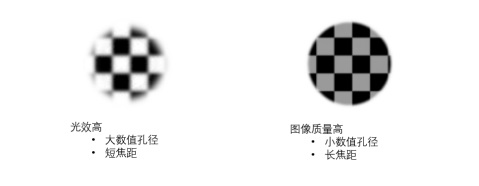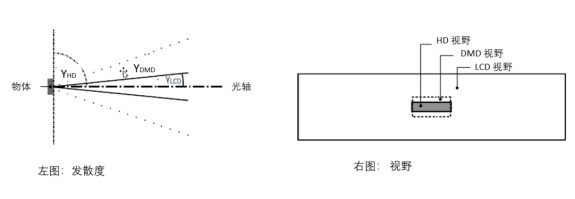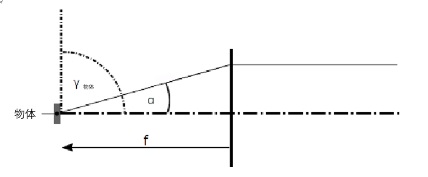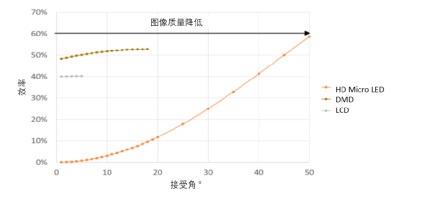To date, car lights have primarily focused on the principles of non-imaging optics for design, as well as optimizing various performances, such as how to achieve high optical efficiency in increasingly compact optical modules.
However, for digital projection headlamp, in addition to conventional lighting functions, image quality of the projection must also be considered. This means achieving high contrast and low distortion. According to aberration theory, to achieve high standards of image quality, the projection module must have low divergence and a small projection field of view.
However, in practical applications, almost all car light projection modules have high divergence and a large field of view. The large field of view is limited by the module's heat dissipation needs, while high divergence is determined by the conversion properties of phosphors.
Therefore, the image quality of these projection modules can only be achieved through a smaller numerical aperture and a longer focal length, which directly results in lower optical efficiency and larger projection module sizes. These are inconsistent with the current trends in car light design. Their relationship is shown in the diagram below.

(Diagram: The opposing relationship between projection image quality and optical efficiency.)
Therefore, it is important to balance these variables.
Two parameters have the greatest impact on the imaging optics of projection modules: divergence (see the left diagram below) and field of view size (see the right diagram below).

DMD, LCD, and Micro-LED projection imaging module's main technical parameters are listed in the table below.
Parameter | HD(Micro-LED) | DMD | LCD |
Divergence (°) | +/-90° | +/-18° | +/-5° |
Field of View (㎜) | 13*3.25 | 12.45*6.56 | 86*21.5 |
Resolution Px | >10000 | 1152*1152 | 300*100 |
Contrast Impact | Light Leakage Between Pixels | Flat Light | |
Maximum Luminous Flux Lm | 10000 | 4000 | 9000 |
Transmission Loss | 0 | 47% | 60% |
In addition to dispersion and projection field of view, some other parameters also need to be considered, such as resolution, contrast, and luminous flux.
The optical principles of imaging optics are shown below:

f- <span style
α - Optical Acceptance Angle
Y - Maximum Divergence AngleNA - Numerical Aperture
The efficiency of imaging optical components is equal to the ratio of the light accepted by the numerical aperture (NA) to the light emitted by the image-forming element. For the above three modules, this means:
DMD has an input light efficiency of 53%, producing a divergence angle of approximately +/-18°.
LCD has a light efficiency of 40%, producing a divergence angle of approximately +/-5°.
HD has an input light efficiency of 100%, with a divergence angle close to +/-90°.
The following diagram shows the relationship between acceptance angle and optical efficiency for each module.

Due to Fresnel reflection losses of the projection headlamp lens, the maximum efficiency of DMD is limited to 53%, and the maximum efficiency of LCD is limited to 40%. Furthermore, it is evident that to achieve the same efficiency as DMD or LCD, micro LED requires a higher acceptance angle.
The magnification of the imaging system refers to the ratio of the image to the image-forming element. The size of the image-forming element is fixed. Therefore, the required image field of view directly affects the focal length needed by the system.
Generally, the larger the focal length, the better the image quality. If the focal length is relatively short, splitting the refractive index into several lenses can improve image quality while reducing the overall length of the module.
Overall, digital projection headlamps bring new functionalities to automotive lighting, enhancing active safety and interaction between people and vehicles. However, digital projection headlamps are still relatively expensive, making it crucial to better balance cost and image quality.

Inquiry
Excellent Customer Service Ability
Key customer manager mechanism
Oversea supporting points
Excellent Process Control Ability
Fully automated production
DMC traceability management
VDA6.3 / IATF16949 verifications
Excellent R&D Ability
Advanced technology new product development cooperation
Cost-effective optical solution proposal based on customer needs
Ecosystem resource integration